p.22
p.26
p.30
p.34
p.38
p.42
p.46
p.50
p.54
Simulation of Environmentally-Assisted Material Degradation by a Thermodynamically Consistent Phase-Field Model
Abstract:
Environmentally-assisted material degradation involves mass transport and mechanical processes interacting in the material. A well-known example is hydrogen-induced stress-corrosion cracking. One major challenge within this scope is the quantification of the coupling mechanisms in question. The computational modeling of environmentally-assisted cracks is the key objective ofthis investigation and realised within the theory of gradient-extended dissipative continua with length-scales. The modeling of sharp crack discontinuities is replaced by a diffusive crack model based onthe introduction of a crack phase-field to maintain the evolution of complex crack topologies. Withina thermodynamical framework allowing for mechanical and mass transport processes the crack phase-field is capable to model crack initiation and propagation bythe finite element method. As complexcrack situations such as crack initiation, curvilinear crack patterns and crack branching are usuallyhard to realise with sharp crack models, they can be assessedwithout the requirement of a predefinedcrack path within this method. The numerical modeling of a showcase demonstrates a crack initiationas well as a crack propagation situation with respect to the determination of stress-intensity factors; acrack deviation situation with a curvilinear crack path is modeled by the introduction of a geometricalperturbation and a locally enhanced species concentration
Info:
Periodical:
Pages:
38-41
Citation:
Online since:
September 2016
Authors:
Price:
Сopyright:
© 2016 Trans Tech Publications Ltd. All Rights Reserved
Share:
Citation:


